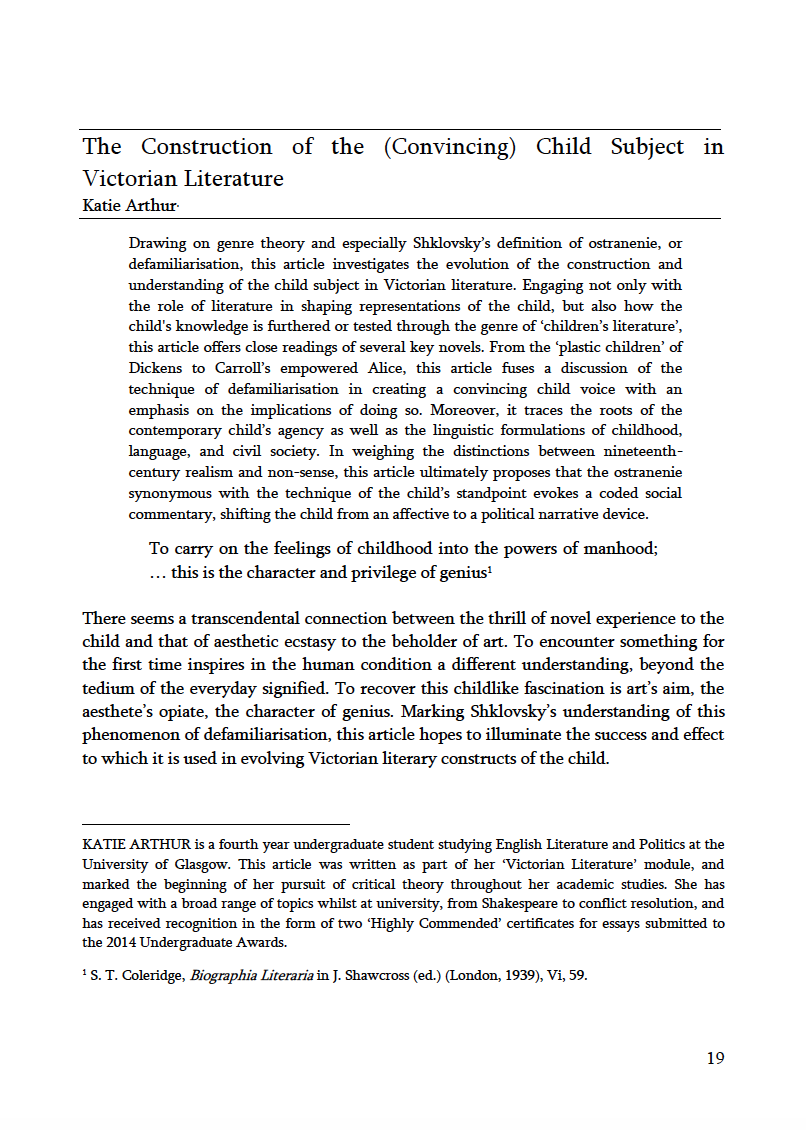The Construction of the (Convincing) Child Subject in Victorian Literature
DOI:
https://doi.org/10.36399/GroundingsUG.8.205Keywords:
Child Subject, Character, Construction, Victorian, Literature, Representation, Voice, Convincing, AgencyAbstract
Drawing on genre theory and especially Shklovsky’s definition of ostranenie, or defamiliarisation, this article investigates the evolution of the construction and understanding of the child subject in Victorian literature. Engaging not only with the role of literature in shaping representations of the child, but also how the child's knowledge is furthered or tested through the genre of ‘children’s literature’, this article offers close readings of several key novels. From the ‘plastic children’ of Dickens to Carroll’s empowered Alice, this article fuses a discussion of the technique of defamiliarisation in creating a convincing child voice with an emphasis on the implications of doing so. Moreover, it traces the roots of the contemporary child’s agency as well as the linguistic formulations of childhood, language, and civil society. In weighing the distinctions between nineteenth-century realism and non-sense, this article ultimately proposes that the ostranenie synonymous with the technique of the child’s standpoint evokes a coded social commentary, shifting the child from an affective to a political narrative device.
References
J. Carey, The Violent Effigy: A Study of the Dickens’ Imagination (London, 1973).
L. Carroll, Alice’s Adventures in Wonderland and Through the Looking Glass (London, 2012).
G. K. Chesterton, Appreciations and Criticisms of the Works of Charles Dickens (London, 1911).
S. T. Coleridge, Biographia Literariain J. Shawcross (ed.) (London, 1939), Vi.
C. Dickens, Great Expectations (1860-1; London, 2003).
C. Dickens, The Old Curiosity Shop (1841; London, 1985).
J. Dunisbere, Alice to the Lighthouse: Children’s Book and Radical Experiments in Art (Hampshire, 1987).
R. Ellmann, Oscar Wilde (London, 1987).
A. Hunter, ‘Arthur Morrison and the Tyranny of Sentimental Charity’ (2013) 56:3 English Literature in Transition, 1880-1920, 292-312.
R. Jakobson, ‘Two Aspects of Language’ in J. Rivkin & M. Ryan (eds.), Literary Theory: An Anthology 2nd Edition (Oxford, 2004), 76-80.
R. Jakobson, Studies on Child Language and Aphasia (Paris, 1971).
J. Kincaid, ‘Dickens and the Construction of the Child’ in W. Jacobson (ed.), Dickens and the Children of Empire (Hampshire, 2000), 29-42.
L. Langbauer, ‘Ethics and Theory: Suffering Children in Dickens, Dostoyevsky and Le Quin’(2008) 75:1 English Literary History 89-108.
J-J. Lecercle, The Philosophy of Nonsense: The Intuitions of Victorian Nonsense Literature (New York, 2002).
S. Lerer, Children’s Literature: A Reader’s History, from Aesop to Harry Potter (Chicago, 2008).
A. Morrison, A Child of the Jago (1896; London, 1969).
R. Pattinson, The Child Figure in English Literature (Georgia, 2008).
K. Reynolds, Radical Children’s Literature: Future Visions and Aesthetic Transformations in Juvenile Fiction (Hampshire, 2007).
V. Shklovsky, ‘Art as Technique’ in J. Rivkin & M. Ryan (eds.), Literary Theory: An Anthology, 2nd Edition (Oxford, 2004), 15-21.
L. C. Roberts, ‘Children’s Fiction’, in P. Brantlinger & W. B. Thesling (eds.), A Companion to the Victorian Novel (Oxford, 2002), 353-369.
S. Shuttleworth, The Mind of the Child: Child Development in Literature, Science and Medicine, 1840-1900 (New York, 2010).
B. Silverstone, ‘Children, Monsters and Words in Alice’s Adventures in Wonderland and Through the Looking Glass’ (2001) 30:4 Cambridge Quarterly 319-336.
M. Yaguello, Language Through the Looking Glass: Exploring Language and Linguistics (Oxford, 1998).

Published
Issue
Section
License
Copyright (c) 2015 Katie Arthur

This work is licensed under a Creative Commons Attribution 4.0 International License.
The CC BY 4.0 license is a Creative Commons license. This is a non-copyleft free license that is good for art and entertainment works, and educational works. It is compatible with all versions of the GNU GPL; however, like all CC licenses, it should not be used on software. People are free to: Share — copy and redistribute the material in any medium or format; Adapt — remix, transform, and build upon the material for any purpose, even commercially. The licensor cannot revoke these freedoms as long as you follow the license terms. But they must conform to the following terms: Attribution — You must give appropriate credit, provide a link to the license, and indicate if changes were made. You may do so in any reasonable manner, but not in any way that suggests the licensor endorses you or your use. No additional restrictions — You may not apply legal terms or technological measures that legally restrict others from doing anything the license permits.
Please check individual article PDF copies to see if any additional restrictions apply.







